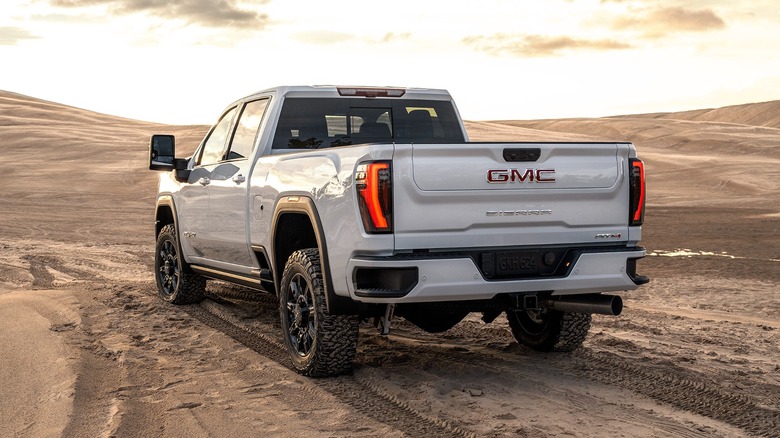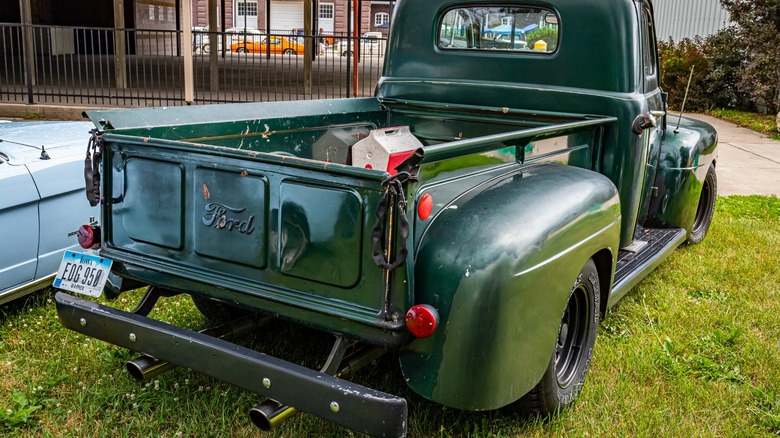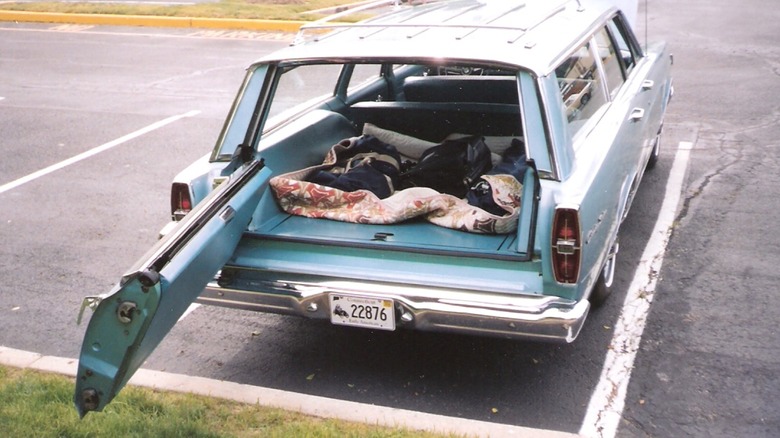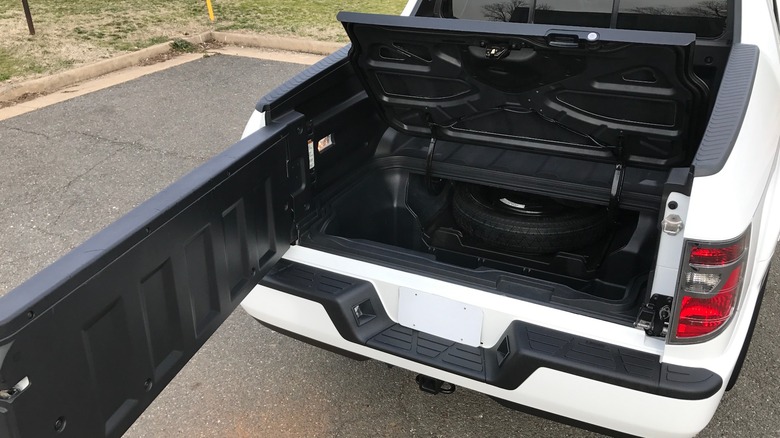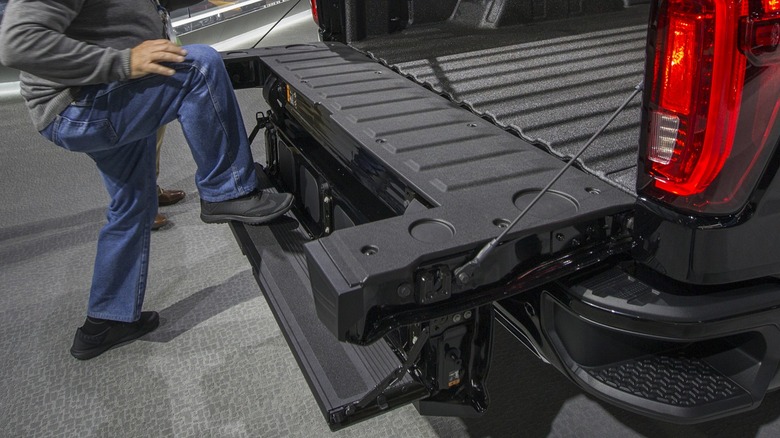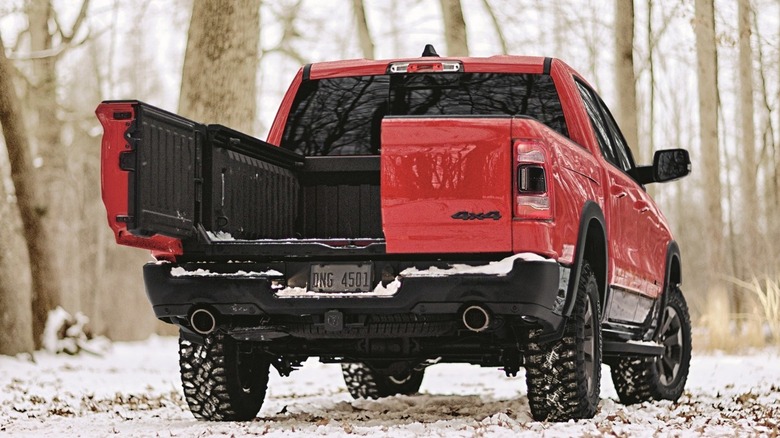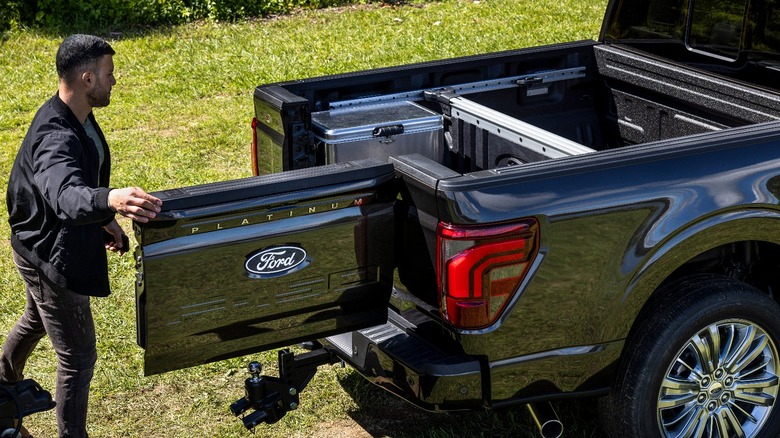100 Years Later: Here's How Truck Tailgates Have Changed
From the ranches of Montana to the streets of New York, pickup trucks have been a favorite for the average American to drive. Engines evolved, designs changed, and trucks got more expensive, but one defining feature that's often overlooked is the tailgate. The durable metal was once solely used to contain cargo in the truck bed. Today, it can transform into extensions for the cargo bed, a workstation, and even incorporate a sound system.
Early tailgates had a utilitarian design, keeping cargo from rolling off the truck. Although this design served its original purpose, industry leaders like Ford realized that it could offer more. In multiple installments after the 1920s, with Ford at the forefront and other manufacturers playing along, pickup truck tailgates underwent gradual redesigns and enhancements.
Initially, chains were added to make the tailgates fall parallel with the cargo bed when opened, extending the bed's space. Then, they were redesigned to open sideways along with the original vertical swing. In the '80s, some tailgates were made removable. By the 2000s, they were more loaded than ever with accessories on every inch; be it sound systems, electrical switches, workstations, and more.
Early days: 1920s to 1960s
In 1925, Ford re-introduced the Model TT with a factory-installed cargo bed, setting the stage for the modern pickup trucks as we know them today. It featured a flat, hinged metal panel at the rear end of the vehicle bed that would prevent cargo from falling off the truck. Since it was hinged, it could be opened to load and unload cargo easily. This was one of the earliest tailgates the pickup truck industry had seen.
Then, in 1948, Ford released the iconic F-series. The F-1 pickup truck's cargo bed had side panels and a tailgate with tapered edges. The tailgate also featured drop-chains, so that it could be opened 90 degrees whenever there was a need to extend the cargo bed. 13 years later, Ford made two more improvements to the tailgates in the 1961 F-series: the addition of door handles, quick-action latches, and support cables instead of chains.
Tailgates back then didn't do much. You'd unfold them, load cargo, and close them up again. At best, over 40 years, they'd had an aesthetic redesign with minor mechanism changes that allowed them to be more user-friendly. It was now time for a breakthrough — and that, too, at the hands of Ford.
Ford and General Motors in the '60s and '80s
In 1966, Ford introduced the "Magic Doorgate" in its Country Squire station wagons. With some clever engineering, Ford designed a tailgate that could open sideways like a door, in addition to the traditional drop-down design. Sure, it was not a pickup truck tailgate, but the design did influence tailgate designs seen in modern pickup trucks today, like the Honda Ridgeline.
Since the tailgate could not be opened with the rear window up, Ford worked to improve this two-way Magic Doorgate to a three-way configuration in 1969. Regardless of the window being up or down, the tailgate could be opened. This design became popular and eventually, Chrysler and American Motors Corporation adopted it, too.
However, the company that took tailgate engineering up a notch was General Motors. It introduced the clamshell tailgate in its 1971 Buick Estate wagons, calling it a "Glide-Away Tailgate." Instead of swinging out vertically or horizontally, this tailgate could be retracted under the cargo bed, completely out of sight. However, GM eventually dropped this design, going back to the rear-door-styled tailgates; the Glide-Away tailgate was both hard to clean and maintain, as well as fix if it broke.
In the '80s, Ford made their F-series and Rancher pickup truck tailgates removable. This feature did make the loading and unloading of cargo easier, but boosted tailgate theft. As a preventive measure, Ford eventually redesigned these removable tailgates and included locking mechanisms.
[Featured image by Josephew via Wikimedia Commons | Cropped and scaled | CC BY-SA 3.0]
Honda Ridgeline's Dual-Action tailgate
Although this design was not new, Honda with its "Dual-Action” tailgate brought about a major disruption in the design of tailgates in 2006. Reviving the Ford's Magic Doorgate mechanism from the 1966 Country Esquire, Honda's Ridgeline featured a tailgate design that allowed it to not only open downwards like a standard tailgate, but also sideways like a conventional door. This design was a first for pickup trucks, but it turned out to be a success, earning the Ridgeline multiple accolades.
The "Dual-Action" tailgate appears to be just a standard tailgate hinged differently. You can only truly reap the benefits of the swing-out design when you use it in conjunction with the in-bed hidden storage. For ages, truck users had complained of a lack of covered storage options in pickup trucks for securing smaller cargo.
While conventional tonneau covers solved the problem, they reduced the bed's storage capacity. The under-bed storage design also solved the issue, but was incredibly hard to access with drop-down tailgates. The swing-open design of Honda's Dual-Action tailgate is what found the sweet spot, maximizing the utility of the truck bed.
[Featured image by John Pollard via Wikimedia Commons | Cropped and scaled | CC BY-SA 4.0]
GMC and Chevy's tailgates
General Motors re-thought the tailgate in 2019 — called "MultiPro" for GMC Sierra and "MultiFlex" for Chevrolet Silverado — and ended up building one of the most versatile and tech-loaded tailgates out there. Structurally, it is divided into two portions horizontally (the primary and secondary portions), which you can use in more than six different configurations.
Firstly, you can drop it down like a regular tailgate does to increase the bed length. Then, you can lift up the inner wall of the upper portion to get a tailgate for the extended bed. When the tailgate is closed, you can drop the upper portion to convert it into a workstation for worksites. And, by lifting the desk surface, you can prevent taller cargo from falling off.
If you need a step to climb into the truck bed, simply unfold the tailgate fully — which will also allow you to reveal the speakers for tailgate parties. And finally, to increase your reach to the inside of the bed, you can drop both the upper and lower panels, without unfolding the step.
Although the Ford F-150 got the extra retractable step in the tailgate back in 2006, General Motors took the game to the next level with this tailgate. Its engineering with the MultiPro tailgate is reminiscent of the Glide-Away tailgate that it released back in the '60s.
Ram's Multifunction tailgate
Ram tried to one-up General Motors by introducing its "Multifunction Tailgate." In February 2019, Ram announced that this tailgate had a dampened drop-down design, like most other tailgates. In addition, it was split into two with a 60/40 ratio, and could open like a barn door, too. This opening allowed for increased access to the cargo bed, especially compared to GM's MultiPro and Multi-Flex tailgates.
The Multifunction tailgate can swing 88 degrees outward, providing a wide range of motion, and aligning with the truck bed walls almost perfectly. You can either swing-open both doors, or one at a time. This tailgate opens especially well with the Mopar Bed Step, that you can install separately to your Ram pickup truck for easier access to the truck bed.
The barn door design, like the Ridgeline's Dual-Action tailgate, was not an entirely new concept. The 2002 Lincoln Blackwood (a subsidiary of Ford Motors) featured a 50/50 split door design. However, the Blackwood was not a commercial success. It was a "luxury" pickup truck and had a permanent tonneau — not exactly suitable for rough use. Its barn-door tailgate couldn't be dropped down like a standard tailgate either, unlike the Ram's Multifunction tailgate.
Ford's Pro Access tailgate
From 2019 until September 2023, GM and Ram may have thought they'd bested Ford. However, it didn't take long for Ford to come up with an even better design. The Pro Access Tailgate, available for the Tremor trims and beyond, is Ford's idea of a multi-function tailgate.
It has a barn door placed right in the middle of the tailgate, taking up about 60% of real estate. The rest of the 40% is divided into two equal portions, placed on either side of the middle barn door — the right portion is hinged to the barn door, and the left one hosts the latches for it.
By pressing a button on the instrument panel, you can drop the full tailgate down. With its dampened fall, it will unfold to give you a bed extender or a workstation — depending on how you want to use it. You can also swing open the door and access the bed with perfect ease. Although you can add a retractable tailgate step to climb into the truck bed, the extended bumper step is already low enough for a comfortable climb.
The key item that Ford got right with this design is the bed accessibility when a trailer is hitched to the truck. With GM's MultiPro/Multi-Flex tailgate, accessing the truck bed was still a problem: When the upper portion would drop down further, it would hit the hitch and potentially damage the tailgate. The awkward 60/40 split meant that the door opening was hard to access from either side when a trailer was hitched. Ford found the right balance with its Pro Access tailgate.
